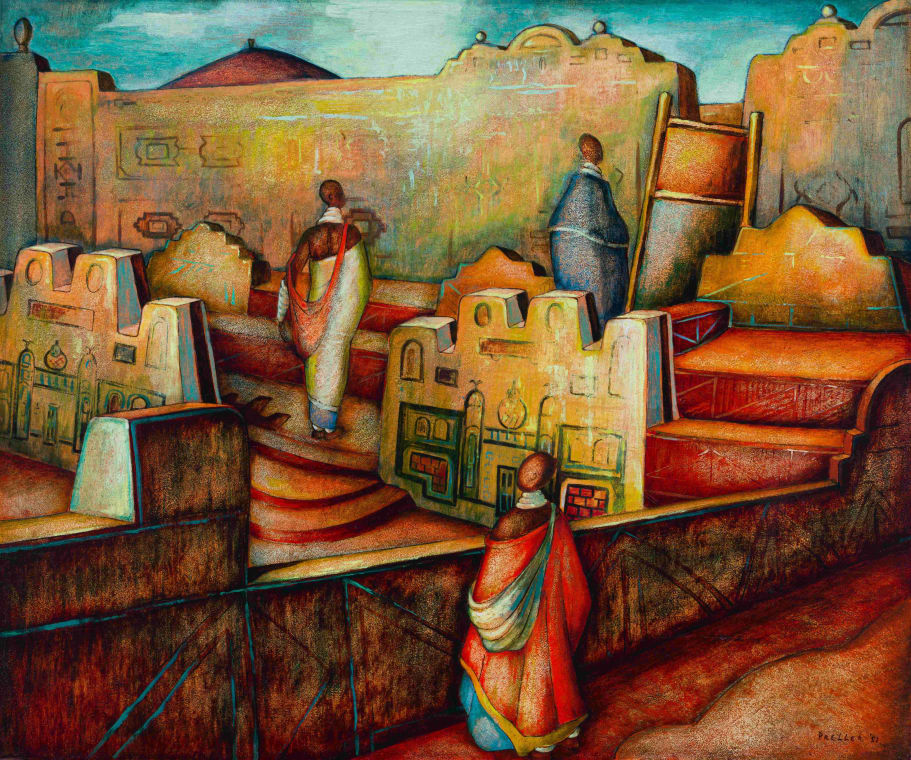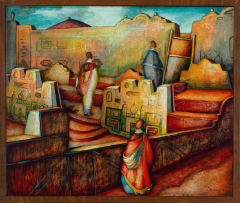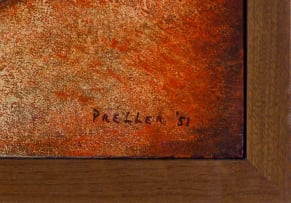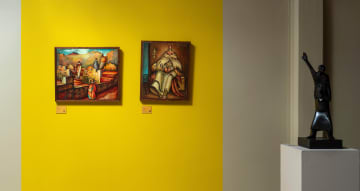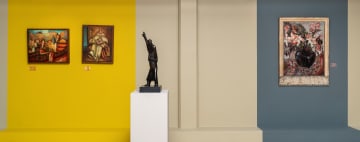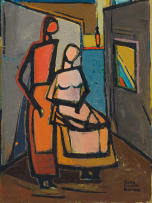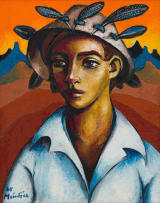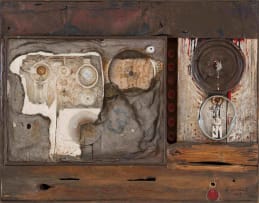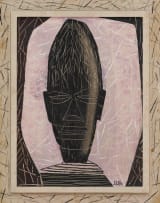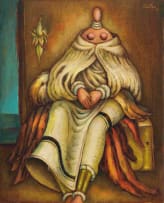Mapogga Terrace
Alexis Preller
Incl. Buyer's Premium & VAT
About this Item
signed and dated '51
Notes
In the December of 1935, having recently returned from a year at the Westminster School of Art in London, and shortly after closing his first ever exhibition at Glen's Music Salon in Pretoria, a twenty-four-year-old Alexis Preller, wide-eyed, motivated and curious, came across a group of women labourers on the northern outskirts of town, each of them turned out in dazzling traditional dress. Hammered and weighty brass rings glinted on their necks and ankles, and coloured beads decorated their aprons and armbands. These were Ndzundza-descended women of the Southern Ndebele people, and their village, to which a young Alexis followed them one day, with its stepped terraces, mud huts, enclosed kraals, and joyful, distinctive, painted walls, would become one of the artist's greatest sources of inspiration. His first painting to include these Ndebele figures, or Mapogga, as they were also called, was Native Study (Mapogges) [sic]; it showed them with long and gently cylindrical limbs and conical breasts, and it was one of the 117 paintings, and the only one by Alexis, exhibited at the Empire Exhibition at Milner Park in Johannesburg from September 1936.
In that same year, a young photographer called Constance Stuart, another ambitious artist who had grown up in Pretoria, became drawn to the mystique of the Mapogga too. Having outgrown her Kodak Box Brownie, trained in London between 1933 and 1935 at the Regent Street Polytechnic School of Photography, and thereafter at the Bavarian State Institute for Photography in Munich, Stuart turned her new Rolleiflex on the tribal cultures of southern Africa, and rather memorably, in her straightforward and black and white style, on the people of the Ndebele (figs. 1 and 2). She and Alexis plainly shared a passion, and they were firm friends by 1938 (Stuart purchased the only Mapogga picture on Preller's fourth solo show, held at the New Group Hall in Queen Street in Pretoria, in October 1938). Consequently, comparing their contemporaneous approaches to their Mapogga subject matter is particularly handy: Stuart's direct and documentary mode helps emphasize the visionary and daring way in which Preller interpreted the same theme. The Mapogga certainly became one of Preller's most iconic, spell-binding and protean motifs, and dominated many of his seminal paintings. Two such examples, both breathtaking and richly symbolic, are featured here. (Lots 191 and 192)
____
Late in 1948 Preller conceived The Kraal (fig. 1 is the second version), a mad, landmark, multi-figural and Brueghel-esque scene based, rather surprisingly, on a traditional Ndebele village. In search of a distinctly African iconography, the work included a disparate collection of references from the continent: a slit drum, a marabou stork, a Baga carving, to name a few. With its lapas, decorative walls and human action, The Kraal became a precursor to a small group of Mapogga village settings executed in the early 1950s. Mapogga Women (fig. 2), now in the Pretoria Art Museum, is one such example, and the scene is easy enough to read: while husbands are out at work, the women, swathed in bright blankets, kneeling on woven mats or straight-backed and seated, chat and get on with domestic chores. While the figures are notably stylised, and the palette pleasingly vivid, the scene is rooted in routine and reality, and not too far removed from one of Constance Stuart's documentary photographs. In comparison, however, the breathtaking Mapogga Terrace, the current lot, while following a similar theme, strikes a different tone entirely. First of all, a celestial atmosphere is set by the golden and blush light that bathes the ledges, walls and the shallow steps. Secondly, the three Mapogga women, calm, knowing and slow-moving, with their small ovoid heads and resplendent robes, evoke a sense of awe and timelessness.
In Preller's imagination, these women had transcended the humdrum, and appeared to him as prophetesses or devotees moving quietly through a sacred space. Most importantly, they seemed to embody and safeguard their ancient traditions. In this context, the familiar and decorative wall paintings take on extra meaning. The colourful designs symbolise the recording of history and custom. While the patterns fade away with seasonal rains, they are restored and brightened again by the women. The walls thus become beautiful palimpsests of an archaic African civilisation, and the women its scribes and custodians.
Provenance
Die Kunskamer, Cape Town.
Private Collection, Johannesburg.
Literature
Esmé Berman and Karel Nel (2009) Africa, the Sun and Shadows, volume I, Johannesburg: Shelf Publishing. Illustrated in colour on page 146 and 147.
